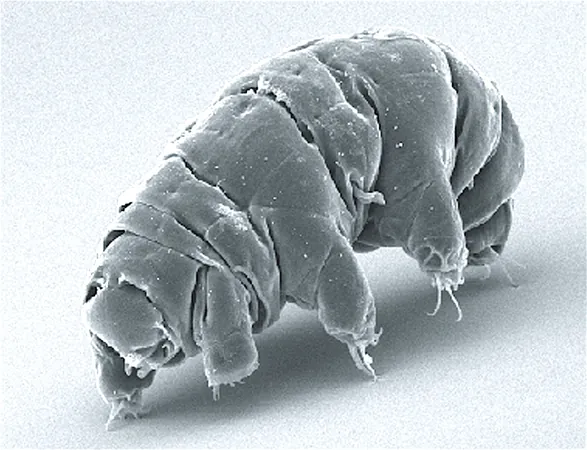
How Tardigrades Could Unlock the Secrets of Survival in Space
2025-04-07
Author: Benjamin
Introduction
The recent 2025 Lunar and Planetary Science Conference held from March 10–14 in The Woodlands, Texas, unveiled groundbreaking proposals aimed at enhancing our understanding of space exploration. Among the standout presentations was a captivating discussion centered on one remarkable organism: the tardigrade, also known as the 'water bear.' Researchers are increasingly looking to these microscopic creatures to solve one of the most pressing questions in astrobiology: How can humans survive in space and the generally inhospitable environments of other planets?
Tardigrades: The Extremophiles
This fascinating study was spearheaded by Isadora Arantes, a NASA ambassador and astronaut candidate, along with Geancarlo Zanatta, an Associate Professor at the Federal University of Rio Grande do Sul. Tardigrades have recently emerged as stars in the study of extremophiles, renowned for their astounding ability to endure extreme conditions that would be catastrophic for most life forms. These tiny creatures can withstand a staggering range of temperatures—from as low as -271°C (-456°F) to scorching highs of over 150°C (302°F)—and thrive under extreme pressures, desiccation, and intense radiation.
Research Findings on Tardigrade Proteins
Arantes and Zanatta have identified crucial proteins, most notably Dsup (Damage Suppressor), which offer insight into the tardigrades’ resilience. The Dsup protein functions like a protective shield, guarding the genetic material from radiation damage, thereby reducing double-strand breaks and maintaining genomic integrity. Using advanced molecular dynamics simulations with Gromacs software, their study demonstrated how Dsup mitigates genetic mutations resulting from radiation exposure.
In addition to Dsup, they explored heat shock proteins (HSPs) and antioxidant enzymes that protect the integrity of proteins during high thermal stress and counteract oxidative damage caused by radiation respectively. Their findings suggest that the adaptive mechanisms of tardigrades mirror those needed for potential life forms to exist in extraterrestrial locations like Mars, Europa, and Titan.
Extraterrestrial Implications
'As we understand it, Mars presents a radiation-rich environment with sporadic liquid water, while icy moons like Europa and Titan possess subsurface oceans with cryogenic conditions,' they explained. Their research underlines how the robustness of proteins in these extreme environments could indicate the possibilities of life in aqueous-ammonia mixtures.
Broader Applications of Tardigrade Research
But the implications of studying tardigrades stretch far beyond astrobiological explorations; they hold the key to significant developments in biotechnology. Enhancing radiation resistance, helping human cells thrive in extreme conditions, and breeding crops that can withstand challenging climates could all be achieved through the genomic secrets of these remarkable organisms. As Arantes and Prof. Zanatta noted, 'These applications underscore the broader impact of extremophiles, not only in space exploration but also in addressing ecological challenges here on Earth.'
Future Research Directions
Looking ahead, they emphasized the importance of integrated computational and experimental studies to further uncover the mechanisms behind extremophile survival. This research could propel our understanding of resilience in both terrestrial and extraterrestrial life forms, ultimately paving the way for successful human missions beyond our planet. As we stand on the brink of potentially discovering life beyond Earth, the tiny tardigrade may just be the hero we need to ensure our survival in the cosmos.









 Brasil (PT)
Brasil (PT)
 Canada (EN)
Canada (EN)
 Chile (ES)
Chile (ES)
 Česko (CS)
Česko (CS)
 대한민국 (KO)
대한민국 (KO)
 España (ES)
España (ES)
 France (FR)
France (FR)
 Hong Kong (EN)
Hong Kong (EN)
 Italia (IT)
Italia (IT)
 日本 (JA)
日本 (JA)
 Magyarország (HU)
Magyarország (HU)
 Norge (NO)
Norge (NO)
 Polska (PL)
Polska (PL)
 Schweiz (DE)
Schweiz (DE)
 Singapore (EN)
Singapore (EN)
 Sverige (SV)
Sverige (SV)
 Suomi (FI)
Suomi (FI)
 Türkiye (TR)
Türkiye (TR)
 الإمارات العربية المتحدة (AR)
الإمارات العربية المتحدة (AR)